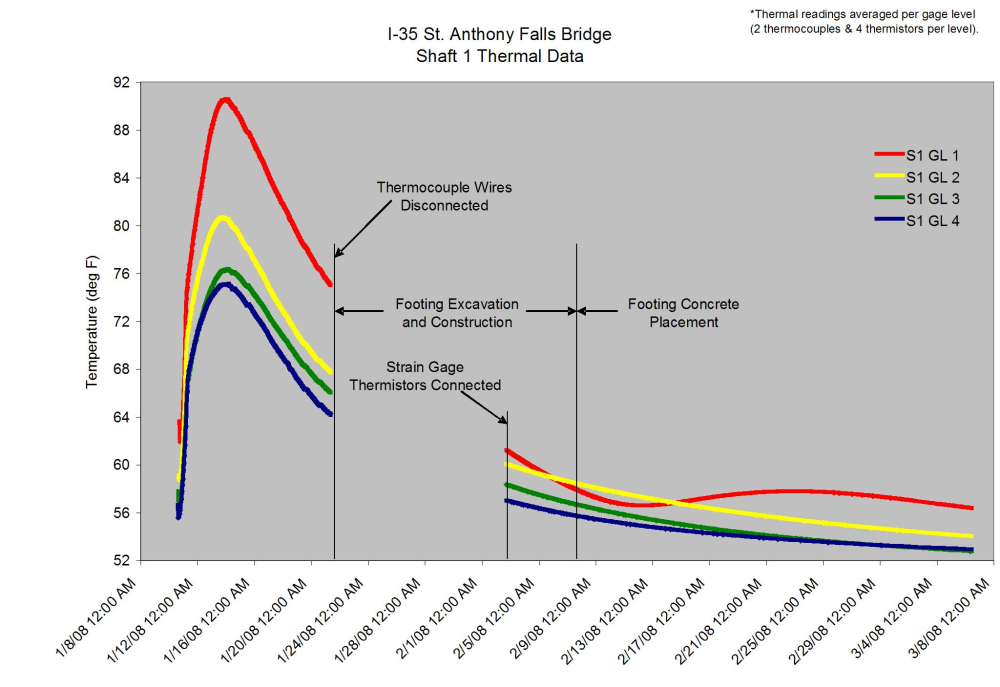Implementation of the Spectral-Analysis Technique
光谱分析读取振动线传感器的有用性取决于其对现场使用的适用性。该设备必须具有成本效益,坚固耐用,低功率,并易于与现有数据收购设备集成。
Campbell Scientific, a data-acquisition company based in Logan, Utah, previously developed time-domain methods to read vibrating-wire sensors. Armed with this experience, instrumentation engineers at Campbell Scientific developed a new vibrating-wire readout module that incorporates spectral analysis. This new module, the AVW200, excites the sensor's wire, samples the response, applies the Fourier transform, and returns the measurement result and diagnostics to the data logger—all within two seconds.
自2008年初以来,AVW200及其无线对应物AVW206就可以使用。从那时起,它们已成功地用于许多应用程序中。以下各节描述了新技术如何使两个大型桥梁项目受益:路易斯安那州休伊·P·朗桥的扩大以及明尼苏达州的I-35 St. Anthony Falls Bridge的重建。*These projects were originally published as case studies on our website, and the projects may be in various stages of completion since that time.
案例研究:Huey P.长桥扩大项目
The four main spans of the Huey P. Long Bridge extend nearly 2,400 ft over the Mississippi River in New Orleans, Louisiana.

这座悬臂的钢铁横穿桥梁于1935年向交通开放,并由新奥尔良公共腰带铁路拥有和运营。目前,该桥在桁架和两条车道之间悬挂在每个桁架的外部之间。基于需要改善车辆交通流量和由于不间断的铁路交通造成的限制,路易斯安那州运输与发展部(LA DOTD)决定扩大桥梁而不是更换桥梁。
The bridge widening will facilitate an increase in roadway width on each side of the bridge from its current width of 18 ft to 40 ft. The widening will entail the addition of upstream and downstream trusses parallel to the existing truss. The bridge piers are being modified with additional concrete encasements and steel frame to support the two new widening trusses.

A structural health-monitoring program is included in the construction contract as a proactive measure to assess whether the anticipated amount of load is being transferred from the widening truss members to the existing truss members.
CTLGroup was awarded the contract to design and install the truss-monitoring system according to the specifications for the Huey P. Long Bridge widening project. The truss-monitoring specification required the following:
- Determination of initial dead-load stresses in existing eyebar members
- 安装应变量量仪以测量433个成员的施工相关应力
- Installation of strain gages for measurement of live-load stresses in 31 members
- Installation of biaxial tilt meters on each of the five existing bridge piers
- Monitoring system to read the gages, make comparisons with predicted values, and provide daily reports throughout the three-year construction process
- 进行负载测试以校准监视系统
A total of 433 existing truss members are monitored with an array of 827 static and dynamic strain gages designed to measure axial and bending load effects. In addition, tilt meters monitor the inclination of the piers. For the static system, CTLGroup chose vibrating-wire strain gages based on cost, built-in temperature compensation, and the ability to run long distances with lead wires.
The truss-monitoring data-acquisition system is composed of two separate monitoring systems: a static-load monitoring system and a live-load monitoring system, as shown in Fig. 12.

The static system uses 23 track-side-mounted NEMA enclosures that contain AM16/32 multiplexers to read 777 vibrating-wire sensors on 433 members. In addition, five piers were monitored using ten vibrating-wire tilt meters as well as ambient temperature, wind speed, and wind direction. Because of the need for wireless communication between multiplexers, data loggers, and the central computer, the system was configured using a combination of 24 AVW206 modules and RF401 spread-spectrum radios. The multiplexers read the sensors, perform the signal processing, and transmit the data wirelessly to one of four CR1000 dataloggers mounted on the track-side handrail. These data loggers then transmit the data wirelessly to the MTI office trailer approximately one-fourth mile from the bridge site.
The purpose of the system is to measure stresses (strains) in identified members and compare them with predicted response during the bridge-widening construction process. This is accomplished by:
- 建立针对分阶段建设的预测响应的限制
- Accounting for baseline fluctuations (traffic/locomotive loads and temperature effects)
- 将测量与预测响应进行比较
- Automated flagging of limits outside of predicted response
The system runs continuously and collects data approximately once every ten minutes. It posts the data to a password-protected website. The website visually flags (by color) data that are outside predetermined limits.
With hundreds of vibrating-wire sensors involved, this monitoring project provided an appropriate setting to apply the new spectral-analysis method. The outcome was very positive. Historically, an application with so many vibrating-wire measurements would require extra effort to validate measurements and identify noise-compromised data. Typically, some data would be lost due to noise interference. In this case, however, spectral analysis eliminated noise issues. No data were lost, and no extra effort was needed to identify noise-compromised data.
新方法提供的诊断也被证明是有益的,并且在整个项目中广泛使用。CTLGROUP报告说,如果没有AVW206,解决问题问题就不可能很容易解决。尽管他们以前已经使用了时间域解决方案,但这种经验使它们牢固地落后于光谱分析方法。新万博2019最新活动啊
For more information, refer to the“路易斯安那州:监视桥扩展”案例研究.
Case Study: St. Anthony Falls Bridge Foundation Monitoring
On August 1, 2007, the I-35W St. Anthony Falls Bridge over the Mississippi River in Minneapolis, Minnesota, collapsed in the middle of rush hour.

(Photo courtesy of Mike Wills)
The collapse killed 13 people and opened the eyes of policymakers and engineers alike to the serious nature of America’s failing infrastructure. A tremendously cooperative effort to quickly and safely replace the bridge resulted. It harnessed today’s technologies and continues to provide insight into bridge performance and long-term health. To that end, a program was instituted to show how internal instrumentation could be used to increase quality assurance, monitor construction loads, and subsequently show traffic and wind-load effects on the long-term pier performance.
This was the first part of a larger program involving the entire bridge, and it pertained only to one of the three elevated piers, specifically the Southbound Pier 2 columns and foundations. Therein, two types of strain gages and thermometers were installed to monitor three phases of the bridge and foundation system: (1) internal concrete curing temperature of the foundation elements, (2) construction loads, and (3) long-term health.
Four levels of six strain gages each were installed in two of the eight 100-ft-deep drilled shaft foundation elements (48 gages total). Gage levels were designated to identify load-carrying contributions from various soil layers. These levels were at the top of the shaft (ground surface), top of the soft rock, top of the competent rock, and bottom of the shaft.
Each gage level consisted of four vibrating-wire strain gages positioned at quarter points around the circumference of the shaft cross section. Two of the four vibrating-wire gages at each level were coupled with a resistive strain gage situated at opposite sides of the shaft. This scheme provided long-term stability with the slower vibrating-wire gages along with fast measurements from the resistive gages during dynamic events.
In addition to the foundation measurements, two levels of four vibrating-wire strain gages were installed in the two columns supporting the two southbound concrete box girders (16 total vibrating-wire gages). The first level was at the mid-height of the columns; the second was at the base of the column. Mid-level gages were duplicated with resistive strain gages for measuring short-duration transient events.
使用两个单独的数据收购系统来测量振动线和电阻应变量。用AVW200读取振动线量尺寸,并使用CR1000数据编号录制,包括振动线内部热敏电阻录音。使用Campbell Scientific的CR9000高速数据采购系统测量电阻量规。每两分钟采样一次振动线量规,然后将采样周期放慢到15分钟的间隔。在100 Hz处采样电阻量;每15分钟记录一次平均,最大和最小值。这两个系统都用太阳能电池板和深循环电池进行自动,并且每个系统都使用蜂窝调制解调器将数据上传到远程主机服务器。这种安排使数据收购系统可以独立于现场建设功率和通信,并且不会干扰日常的建设活动。数据收购系统的关键方面是远程数据监视,远程程序下载以及随着数据收购要求的增加和减少而远程重新配置。
Phase 1 involved internal concrete temperature monitoring. The embedded thermistors internal to the vibrating-wire strain gages provided one means of assuring that concrete temperatures stayed within acceptable ranges. Fig. 14 shows the internal shaft temperature at each of the gage levels over the course of shaft and footing construction.
Fig. 14. Internal shaft temperature at the gage levels
单击图以获取较大图像。
第2阶段监测了增加的负载以及如何随着施工的进行,如何分配轴的长度。图15显示了码头2脚下的一根竖井以及施工里程碑的负载。该图表明,将近3500 kIP的总轴负荷在末端轴承上有抵抗力,其余载荷由岩层侧剪切携带。在5月29日至7月9日之间,负载步骤显而易见,显示了15个盒子段段中的每个部分。

Phase 3 is ongoing. It uses the calibrations and correlations derived during Phase 2 to monitor the long-term health of the bridge. Variations in shaft and column loads can identify aberrant conditions and alert officials to take appropriate actions.
This project, as with the Huey P. Long Bridge project, was well suited to demonstrate the benefits of the spectral-analysis method for reading vibrating-wire sensors. Not only did this project involve a large number of vibrating-wire sensors, but the setup was located five feet from a 1000-KW generator. As before, the outcome was very positive. Even with the large generator nearby, no data were lost due to noise, and no extra analyses were needed to determine if measurements had been compromised by noise.实际上,原始数据每15分钟都会自动发布到公开可用的网站,而无需审查或资格。因为新方法的成功的project, the program manager already has plans to make it a part of two future bridge-monitoring projects.
For more information, refer to the“明尼苏达州:灾难恢复的桥梁”的案例研究.

